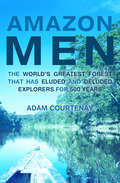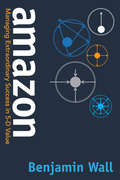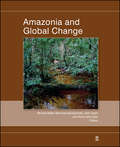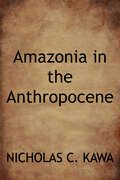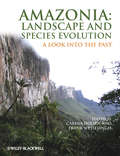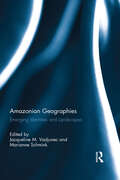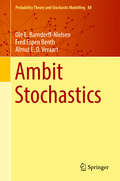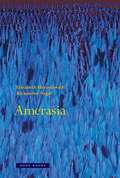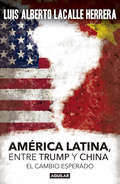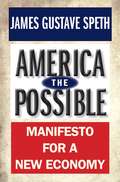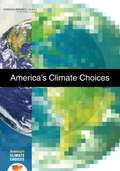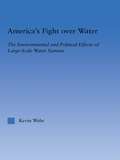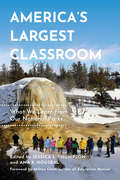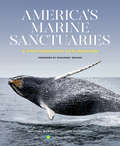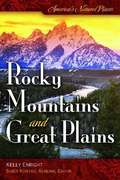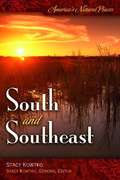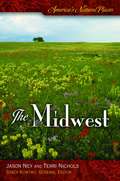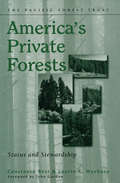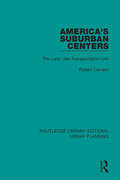- Table View
- List View
Amazon Adventure: How Tiny Fish Are Saving the World's Largest Rainforest
by Sy Montgomery Keith Ellenbogen<P>Considered the “lungs of the world,” the Amazon provides a full fifth of the world’s oxygen, and every year unsustainable human practices destroy 2.7 million acres. What can be done to help? That’s where Project Piaba comes in. <P>Join the award-winning author Sy Montgomery and the photographer Keith Ellenbogen as they traverse the river and rainforest to discover how tiny fish, called piabas, can help preserve the Amazon, its animals, and the rich legacy of its people. Amazon Adventure is an eye-opening—and ultimately hopeful—exploration of how humanity’s practices are affecting and shaping not only the Amazon, but our entire environment. <P><B>Winner of the 2018 Riverby Award</b>
Amazon Men: The World's Greatest Forest that Has Eluded and Deluded Explorers for 500 Years
by Adam Courtenay“Captivating . . . An examination of complex and contradictory human responses to the development of the Amazon and to its preservation” (The Australian). Amazon Men is about conquistadors and botanists, colonizers and human rights activists, slave traders and philanthropists—that is, people who have variously tried to conquer, rework, map, enslave, and save this region and its river system, each according to the needs and zeitgeist of their time in history. The environmental battles of today are part of a long-running story that’s been going on since Europeans first discovered this impenetrable ocean of green. For centuries there’s been a war of attrition between the greatest ecosystem and the greatest predator. Up until now, the predator has failed. Amazon Men is about those who’ve tried to conquer and exploit the Amazon—and those who’ve tried to understand and savor it. Conquistadors Francisco de Orellana and Lope de Aguirre play their parts as representatives of the Age of Discovery. Charles Marie de La Condamine is a perfect foil for the Age of Enlightenment. Alexander von Humboldt appears as a scientist of the Romantic age, seeking unity in the midst of chaos. Walter Hardenburg represents the machine age, defying the industrial imperatives of his time to oppose unfettered colonial capitalism. Sydney Possuelo, the greatest living Amazonian explorer, represents the ongoing conflict between modern expansion and environmental causes. What do their experiences tell us about our attitude to the unexplored and unknown? The stories of Amazon Men recount deeds of bravery and acts of brilliance, but also forgotten holocausts where guns, germs, and steel have all played their roles.
Amazon: Managing Extraordinary Success in 5-D Value
by Benjamin WallIn Amazon: Managing Extraordinary Success in 5-D Value, Benjamin Wall offers structured insights into strategically managing value in the key relationships to customers, personnel, business partners, and investors in order to improve value management at any company.The extraordinary success of Amazon is due to market-leading strength in three &“dimensions&” of value: owning the mightiest supply chain to deliver fastest and cheapest the broadest range of products, enhancing what customers and business partners are doing when using the website / online ecosystem, and knowing how to implement the optimal terms and conditions in the after-sales customer experience. Wall takes a look at the unique managerial skill of Amazon and how each of these organizational areas operates externally and internally according to a separate business logic based on a dimension of value.In an original examination, Wall systematically evaluates Amazon by categorizing and connecting its external and internal success factors to dimensions of value. Each &“score&” on an external success factor is linked to an internal success factor in managing processes, organizational culture, and the business model, so that managers and leaders can enhance their own internal success factors and move towards the same successful external factors. Amazon looks to the future where the near-term promise of the company is evaluated to be in the development from online to omnichannel retail, including the sale of services, by reviving out of Amazon&’s past the fourth dimension of value: feeling how to integrate value. The long-term potential of Amazon is set in the context of a sustainable future for retail, based on trends arising today in meaning across multiple communities, which is the emerging fifth dimension of value. Amazon is projected to operate in this value dimension again as a disruptor, and with Wall&’s help, managers and leaders can reach for the same kind of success.
Amazonia and Global Change
by Pedro Silva Dias Mercedes Bustamante John Gash Michael KellerPublished by the American Geophysical Union as part of the Geophysical Monograph Series, Volume 186.Amazonia and Global Change synthesizes results of the Large-Scale Biosphere-Atmosphere Experiment in Amazonia (LBA) for scientists and students of Earth system science and global environmental change. LBA, led by Brazil, asks how Amazonia currently functions in the global climate and biogeochemical systems and how the functioning of Amazonia will respond to the combined pressures of climate and land use change, such asWet season and dry season aerosol concentrations and their effects on diffuse radiation and photosynthesisIncreasing greenhouse gas concentration, deforestation, widespread biomass burning and changes in the Amazonian water cycleDrought effects and simulated drought through rainfall exclusion experimentsThe net flux of carbon between Amazonia and the atmosphereFloodplains as an important regulator of the basin carbon balance including serving as a major source of methane to the troposphereThe impact of the likely increased profitability of cattle ranching.The book will serve a broad community of scientists and policy makers interested in global change and environmental issues with high-quality scientific syntheses accessible to nonspecialists in a wide community of social scientists, ecologists, atmospheric chemists, climatologists, and hydrologists.
Amazonia in the Anthropocene: People, Soils, Plants, Forests
by Nicholas C. KawaWidespread human alteration of the planet has led many scholars to claim that we have entered a new epoch in geological time: the Anthropocene, an age dominated by humanity. <p><p>This ethnography is the first to directly engage the Anthropocene, tackling its problems and paradoxes from the vantage point of the world's largest tropical rainforest. Drawing from extensive ethnographic research, Nicholas Kawa examines how pre-Columbian Amerindians and contemporary rural Amazonians have shaped their environment, describing in vivid detail their use and management of the region's soils, plants, and forests. At the same time, he highlights the ways in which the Amazonian environment resists human manipulation and control--a vital reminder in this time of perceived human dominance. <p><p>Written in engaging, accessible prose, Amazonia in the Anthropocene offers an innovative contribution to debates about humanity's place on the planet, encouraging deeper ecocentric thinking and a more inclusive vision of ecology for the future.
Amazonia, Landscape and Species Evolution
by Frank Wesselingh Carina HoornThe book focuses on geological history as the critical factor in determining the present biodiversity and landscapes of Amazonia. The different driving mechanisms for landscape evolution are explored by reviewing the history of the Amazonian Craton, the associated sedimentary basins, and the role of mountain uplift and climate change.This book provdes an insight into the Meso- and Cenozoic record of Amazonia that was characterized by fluvial and long-lived lake systems and a highly diverse flora and fauna. This fauna includes giants such as the ca. 12 m long caiman Purussaurus, but also a varied fish fauna and fragile molluscs, whilst fossil pollen and spores form relics of ancestral swamps and rainforests.Finally, a review the molecular datasets of the modern Amazonian rainforest and aquatic ecosystem, discussing the possible relations between the origin of Amazonian species diversity and the palaeogeographic, palaeoclimatic and palaeoenvironmental evolution of northern South America. The multidisciplinary approach in evaluating the history of Amazonia has resulted in a comprehensive volume that provides novel insights into the evolution of this region.
Amazonian Geographies: Emerging Identities and Landscapes
by Jacqueline M. Vadjunec and Marianne SchminkAmazonia exists in our imagination as well as on the ground. It is a mysterious and powerful construct in our psyches yet shares multiple (trans)national borders and diverse ecological and cultural landscapes. It is often presented as a seemingly homogeneous place: a lush tropical jungle teeming with exotic wildlife and plant diversity, as well as the various indigenous populations that inhabit the region. Yet, since Conquest, Amazonia has been linked to the global market and, after a long and varied history of colonization and development projects, Amazonia is peopled by many distinct cultural groups who remain largely invisible to the outside world despite their increasing integration into global markets and global politics. Millions of rubber tappers, neo-native groups, peasants, river dwellers, and urban residents continue to shape and re-shape the cultural landscape as they adapt their livelihood practices and political strategies in response to changing markets and shifting linkages with political and economic actors at local, regional, national, and international levels.This book explores the diversity of changing identities and cultural landscapes emerging in different corners of this rapidly changing region.This book was published as a special issue of the Journal of Cultural Geography.
Amazonian Mammals: Current Knowledge and Conservation Priorities
by Adrian A. Barnett Wilson R. Spironello Jessica W. Lynch Paulo E. D. Bobrowiec Sarah A. BoyleThe mammal fauna of the Brazilian Amazon is one of the most diverse on Earth with over 450 known species. Bringing together more than 70 of the world’s top experts on Amazonian mammals, this book unites, for the first time, up-to-date data on the current state of knowledge on the ecology of all groups of non-rodent mammals in the Brazilian Amazon, analyses the effectiveness of current conservation programmes and identifies research and conservation priorities for the future.
Ambit Stochastics (Probability Theory and Stochastic Modelling #88)
by Fred Espen Benth Ole E. Barndorff-Nielsen Almut E. VeraartDrawing on advanced probability theory, Ambit Stochastics is used to model stochastic processes which depend on both time and space. This monograph, the first on the subject, provides a reference for this burgeoning field, complete with the applications that have driven its development. Unique to Ambit Stochastics are ambit sets, which allow the delimitation of space-time to a zone of interest, and ambit fields, which are particularly well-adapted to modelling stochastic volatility or intermittency. These attributes lend themselves notably to applications in the statistical theory of turbulence and financial econometrics. In addition to the theory and applications of Ambit Stochastics, the book also contains new theory on the simulation of ambit fields and a comprehensive stochastic integration theory for Volterra processes in a non-semimartingale context. Written by pioneers in the subject, this book will appeal to researchers and graduate students interested in empirical stochastic modelling.
Ambit Stochastics (Probability Theory and Stochastic Modelling #88)
by Fred Espen Benth Almut E. Veraart Ole E. Barndorff-NielsenDrawing on advanced probability theory, Ambit Stochastics is used to model stochastic processes which depend on both time and space. This monograph, the first on the subject, provides a reference for this burgeoning field, complete with the applications that have driven its development. Unique to Ambit Stochastics are ambit sets, which allow the delimitation of space-time to a zone of interest, and ambit fields, which are particularly well-adapted to modelling stochastic volatility or intermittency. These attributes lend themselves notably to applications in the statistical theory of turbulence and financial econometrics. In addition to the theory and applications of Ambit Stochastics, the book also contains new theory on the simulation of ambit fields and a comprehensive stochastic integration theory for Volterra processes in a non-semimartingale context. Written by pioneers in the subject, this book will appeal to researchers and graduate students interested in empirical stochastic modelling.
Amerasia
by Alexander Nagel Elizabeth HorodowichA connected world as imagined by early modern European artists, mapmakers, and writers, where Asia and the Americas were on a continuumAmerica and Asia mingled in the geographical and cultural imagination of Europe for well over a century after 1492. Through an array of texts, maps, objects, and images produced between 1492 and 1700, this compelling and revelatory study immerses the reader in a vision of a world where Mexico really was India, North America was an extension of China, and South America was marked by a variety of biblical and Asian sites. It asks, further: What does it mean that the Amerasian worldview predominated at a time when Europe itself was coming into cultural self-definition? Each of the chapters focuses on a particular artifact, map, image, or book that illuminates aspects of Amerasia from specific European cultural milieus. Amerasia shows how it was possible to inhabit a world where America and Asia were connected either imaginatively when viewed from afar, or in reality when traveling through the newly encountered lands. Readers will learn why early modern maps regularly label Mexico as India, why the “Amazonas” region was named after a race of Asian female warriors, and why artifacts and manuscripts that we now identify as Indian and Chinese are entangled in European collections with what we now label Americana.Elizabeth Horodowich and Alexander Nagel pose a dynamic model of the world and of Europe’s place in it that was eclipsed by the rise of Eurocentric colonialist narratives in the nineteenth and twentieth centuries. To rediscover this history is an essential part of coming to terms with the emergent polyfocal global reality of our own time.
America Latina. Entre Trump y China: El cambio esperado
by Luis Alberto LacalleLa segunda entrega de la saga de Gabriel Keller, un asesino serial montevideano y gris. Otra magnífica novela negra de Hugo Burel. El Uruguay, junto con sus vecinos latinoamericanos, está siendo testigo de una particular e interesante coyuntura histórica: mientras asiste al derrumbamiento de los gobiernos populistas de izquierda, los vecinos del norte eligen un presidente polémico y altisonante, que propone estrategias de repliegue y foco en la producción interna.En este especial contexto, las fuerzas dormidas de China avanzan para expandir su influencia en América Latina, eligiendo al Uruguay como estratégica puerta de entrada. ¿Qué implicancias tendrá para nuestra región este avance? ¿Representa una oportunidad o una amenaza? ¿Qué actitud debería asumir el gobierno y la diplomacia al respecto? El Dr. Luis Alberto Lacalle, apelando a su amplia experiencia como gobernante y líder político, y haciendo gala de un agudo sentido analítico, reflexiona sobre las motivaciones de estos movimientos y aventura propuestas para el mejor futuro del país y la región.
America the Possible: Manifesto for a New Economy
by James Gustave SpethIn this third volume of his award-winning American Crisis series, James Gustave Speth makes his boldest and most ambitious contribution yet. He looks unsparingly at the sea of troubles in which the United States now finds itself, charts a course through the discouragement and despair commonly felt today, and envisions what he calls America the Possible, an attractive and plausible future that we can still realize. The book identifies a dozen features of the American political economy—the country's basic operating system—where transformative change is essential. It spells out the specific changes that are needed to move toward a new political economy—one in which the true priority is to sustain people and planet. Supported by a compelling "theory of change" that explains how system change can come to America, the book also presents a vision of political, social, and economic life in a renewed America. Speth envisions a future that will be well worth fighting for. In short, this is a book about the American future and the strong possibility that we yet have it in ourselves to use our freedom and our democracy in powerful ways to create something fine, a reborn America, for our children and grandchildren.
America's Climate Choices
by Board on Atmospheric Sciences ClimateClimate change is occurring. It is very likely caused by the emission of greenhouse gases from human activities, and poses significant risks for a range of human and natural systems. And these emissions continue to increase, which will result in further change and greater risks. America's Climate Choices makes the case that the environmental, economic, and humanitarian risks posed by climate change indicate a pressing need for substantial action now to limit the magnitude of climate change and to prepare for adapting to its impacts. Although there is some uncertainty about future risk, acting now will reduce the risks posed by climate change and the pressure to make larger, more rapid, and potentially more expensive reductions later. Most actions taken to reduce vulnerability to climate change impacts are common sense investments that will offer protection against natural climate variations and extreme events. In addition, crucial investment decisions made now about equipment and infrastructure can "lock in" commitments to greenhouse gas emissions for decades to come. Finally, while it may be possible to scale back or reverse many responses to climate change, it is difficult or impossible to "undo" climate change, once manifested. Current efforts of local, state, and private-sector actors are important, but not likely to yield progress comparable to what could be achieved with the addition of strong federal policies that establish coherent national goals and incentives, and that promote strong U. S. engagement in international-level response efforts. The inherent complexities and uncertainties of climate change are best met by applying an iterative risk management framework and making efforts to significantly reduce greenhouse gas emissions; prepare for adapting to impacts; invest in scientific research, technology development, and information systems; and facilitate engagement between scientific and technical experts and the many types of stakeholders making America's climate choices.
America's Fight Over Water: The Environmental and Political Effects of Large-Scale Water Systems (Studies in American Popular History and Culture)
by Kevin WehrThis book inquires into the relations between society and its natural environment by examining the historical discourse around several cases of state building in the American West: the construction of three high dams from 1928 to 1963.
America's Great Storm: Leading through Hurricane Katrina
by Haley BarbourWhen Hurricane Katrina hit Mississippi on August 29, 2005, it unleashed the costliest natural disaster in American history, and the third deadliest. Haley Barbour had been Mississippi's governor for only twenty months when he assumed responsibility for guiding his pummeled, stricken state's recovery and rebuilding efforts. America's Great Storm is not only a personal memoir of his role in that recovery, but also a sifting of the many lessons he learned about leadership in a time of massive crisis. For the book, the authors interviewed more than forty-five key people involved in helping Mississippi recover, including local, state, and federal officials as well as private citizens who played pivotal roles in the weeks and months following Katrina's landfall. In addition to covering in detail the events of September and October 2005, chapters focus on the special legislative session that allowed casinos to build on shore; the role of the recovery commission chaired by Jim Barksdale; a behind-the-scenes description of working with Congress to pass an unprecedented, multi-billion-dollar emergency disaster assistance appropriation; and the enormous roles played by volunteers in rebuilding the entire housing, transportation, and education infrastructure of South Mississippi and the Gulf Coast. A final chapter analyzes the leadership skills and strategies Barbour employed on behalf of the people of his state, observations that will be valuable to anyone tasked with managing in a crisis.
America's Largest Classroom: What We Learn from Our National Parks
by Jessica L. ThompsonOver the past 100 years, visitor learning at America’s national parks has grown and evolved. Today, there are over 400 National Park Service (NPS) sites, representing over eighty million acres. Sites exist in every US state and territory and are located on land, at sea, in remote areas, and in major urban centers. Every year, more than 300 million people visit national parks, and several million of them are children engaged in one of many educational programs hosted by the NPS.America’s Largest Classrooms offers insight and practical advice for improving educational outreach at national parks as well as suggestions for classroom educators on how to meaningfully incorporate parks into their curricula. Via a wide collection of case studies—ranging from addressing inclusivity at parks and public lands to teaching about science and social issues—this book illustrates innovations and solutions that will be of interest to nature interpreters, outdoor educators, and policy makers, as well as professors in the sciences writ large.
America's Marine Sanctuaries: A Photographic Exploration
by NAT'L MARINE SANCTUARY FDNAn extraordinary illustrated overview of the National Marine Sanctuary System and a guide to its fourteen protected underwater locationsAmerica's Marine Sanctuaries tells the story of fourteen underwater places so important they are under special protection, together forming the US National Marine Sanctuary System. These sanctuaries, spanning more than 620,000 square miles and ranging from the Florida Keys to the Great Lakes and to the Hawaiian Islands, are critical and breathtaking marine habitats that provide homes to endangered and threatened species. They also preserve America's rich maritime heritage and act as living laboratories for science, research, education, and conservation, offering outdoor recreation experiences for all ages. Through 175 full-color photographs and lively narrative, America's Marine Sanctuaries showcases each of the marine sanctuaries and the creatures that live there, from whales and manatees to Hawaiian monk seals and Laysan ducks, as well as sunken ships from the Ghost Fleet and USS Monitor to Shipwreck Alley. The book underscores how marine sanctuaries have shaped the nation's development, survival, and identity, and celebrates these protected underwater treasures for all they can tell us about our communities, our country, and our world.
America's Natural Places: Pacific And West
by Methea K. SappFrom Alaska As Arctic National Wildlife Refuge to the Milnes and Prairie Preserve of New Mexico, this volume provides a snapshot of the most spectacular and important natural places in the western United States.
America's Natural Places: Rocky Mountains And Great Plains
by Kelly EnrightFrom Rocky Mountain National Park in Colorado to the Tallgrass Prairie National Preserve in Kansas, this volume provides a snapshot of the most spectacular and important natural places in the Great Plains and Rocky Mountains.
America's Natural Places: South And Southeast
by Stacy S. KowtkoFrom the Texas Blackland Prairies to the Middle Atlantic Coastal Plain of the Carolinas, this volume provides a snapshot of the most spectacular and important natural places in the southern United States.
America's Natural Places: The Midwest
by Jason Ney Terri NicholsFrom Iowa's Decorah Ice Cave to the Kitty Todd Nature Preserve in Ohio, this volume provides a snapshot of the most spectacular and important natural places in the Midwestern United States.
America's Neighborhood Bats: Understanding and Learning to Live in Harmony with Them (Revised Edition)
by Merlin D. TuttleA guide to these frequently misunderstood animals that dispels unnecessary fears and encourages an appreciation of bats and their conservation needs. Since its publication in 1988, America&’s Neighborhood Bats has changed the way we look at bats by underscoring their harmless and beneficial nature. In this revised edition, Merlin Tuttle offers bat aficionados the most up-to-date bat facts, including a wealth of new information on attracting bats and building bat houses and a revamped key to the identification of common North American species. The easy-to-understand text, clear illustrations, and spectacular color photographs make this the perfect bat book for the general reader, as well as an invaluable resource for professionals who field questions from the public. Those who provide advice at health and animal control departments, museums, zoos, and nature centers will find it especially useful.
America's Private Forests: Status And Stewardship
by John Gordon Laurie A. Wayburn Constance Best Pacific Forest TrustNearly 430 million acres of forests in the United States are privately owned, but the viability, and indeed the very existence, of these forests is increasingly threatened by population growth, sprawling urbanization, and patchwork development. Scientists, policymakers, and community leaders have begun to recognize the vital role of private forests in providing society with essential goods and services, from sustainable timber supplies to clean water. Yet despite the tremendous economic and ecological importance of private forests, information about their status and strategies for their protection have been in short supply.America's Private Forests addresses that shortcoming, presenting extensive data gathered from diverse sources and offering a concise overview of the current status of privately owned forests in the United States. As well as describing the state of private forests, the book sets forth detailed information on a wide range of approaches to conservation along with an action agenda for implementing those strategies likely to be most effective.Based on extensive research of existing literature as well as interviews and consultation with leading forestry and conservation experts, America's Private Forests is a unique sourcebook that offers a solid basis for discussion of threats to private forests along with an invaluable compendium of potential solutions. It will serve as an invaluable reference for those working to conserve and steward forest resources, including forest owners and their consultants, conservation organizations, and agency personnel, as well as researchers and students involved with issues of forestry, biodiversity, land use, and conservation.
America's Suburban Centers: The Land Use-Transportation Link (Routledge Library Editions: Urban Planning #6)
by Robert CerveroOriginally published in 1989, America’s Suburban Centers looks at how America’s suburban workplaces are being increasingly designed for automobiles rather than people. The emergence of sprawling office complexes devoid of housing, shops and other facilities is giving rise to regional congestion problems because of the ever-greater dependence on automobiles. This book argues that the low-density, single-use, and non-integrated character of America’s suburban centers is a root cause of declining levels of mobility and worsening traffic congestion.

